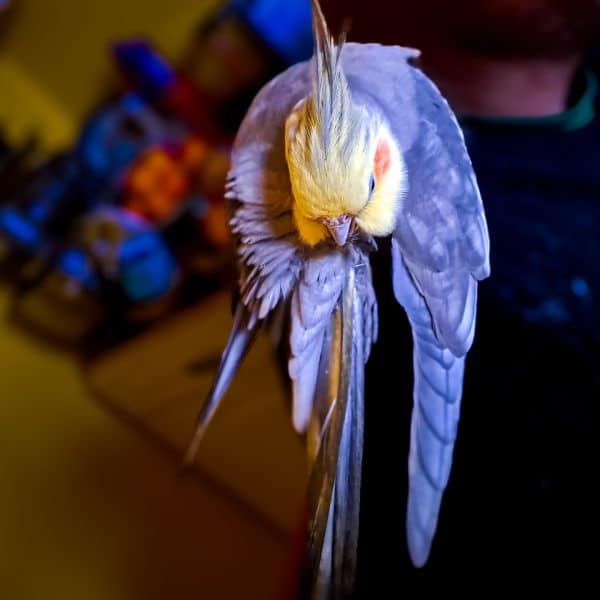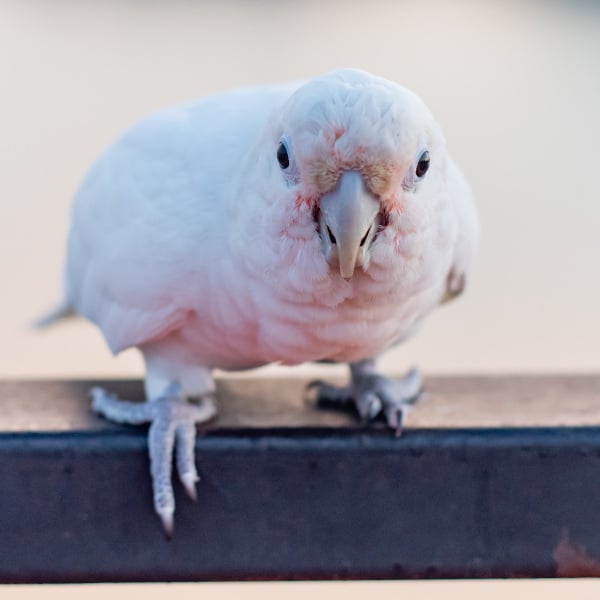Last Updated on by Mitch Rezman
First things first.
You can use Nolvasan solution as an antibacterial flush and Betadine (available in pharmacies and most animal feed stores) to disinfect the wound on the human.
Betadine can also be used on any animal including all parrots, birds and mammals.
There’s nothing wrong with using peroxide.
Grabbing a bar of soap out of the shower or the bathroom sink to clean the wound will only add bacteria residing on that bar of soap and probably should not be used.
The original question came from Quora and the other answers can be found here
On to the main show.
Why on God’s green earth do people say “If you have a bird expect to be bitten”?
You never hear “If you have a dog expect to be bitten”.
“If you have a cat expect to be bitten”.
“If you have a hamster expect to be bitten”.
Bird bites are not acceptable under any circumstances.
Hawks, eagles, and falcons are birds of prey.
They will attack their prey attempting to kill it in order to feed themselves.
Parrots are prey birds ~ They will bite when threatened (in their mind).
If you have any uncertainty about whether a bird in your company may bite you – respect your intuition and do not put yourself in a position to get bit.
Want to give your bird a treat but worried about your fingers getting nipped at?
Put a single treat in a feeder cup or use a millet spray which will put 6 inches between the bird’s beak and your fingers.
Telling a parrot “no” or “no bite” is an exercise in futility.
Think about it how much time you spent teaching your parrot the meaning of the word no let alone the meaning of the word bite?
“Bad dog” may work with some of those furry mammals but not with exotic birds living in your home.
Birds respond well to positive behavior not negative.
Anyone who has a bird or any animal for that matter in their home should be on a clicker training schedule.
With birds five minutes a day of clicker training will change the relationship with your bird in the most remarkable of ways.
Dogs may need a little more time especially if you’re working with multiple length leashes but that’s a whole other story.
Unfortunately, I cannot speak to feline training, it is not my area of expertise.
Clicker training rewards birds for positive behavior.
Once a parrot associates the click with a treat much can be taught in terms of other activities and tricks.
Peaches our Senegal parrot hates any and all human beings but me.
She loves me.
I love her.
Biting is not acceptable.
Her full spectrum cage light comes on at 8:29 AM seven days a week regardless of where we are at.
Sometimes I don’t make it to the cage door immediately to take her out.
If I’m more than five minutes late and put my hand in the cage she will try to bite my finger.
I know that.
So I give her the chance, and if she “lashes out” the cage door gets closed and I don’t return for at least 10 to 15 minutes.
Without exception when I come back to open up the cage door, she is more than happy to climb onto my hand and navigate about on my hand or shoulder.
She has learned that biting will achieve nothing and being nice will get her an almond or a whiskey cork – two of her favorites.
editor’s note: I try really hard to keep up with her whisky cork needs.
When you bring a new bird into your home it may take weeks or months to know when your bird is going to try to bite you.
Forget all that “body language” and “eye pinning” nonsense.
Birds eyes will pin when they are happy OR angry.
A bird’s body language may look “aggressive” but may in fact be trying to send sexual signals.
If you are human and in a relationship with another human, you pretty much know when you have pissed off that other human in your life and to what degree.
You are late coming home, you drank too much, you forgot to pick up whatever it was you were supposed to pick up.
You know that other human in your life is pissed or angry or mildly upset – it’s not rocket science.
The same thing holds true with your bird.
The relationship you have with your bird is based upon mutual trust.
If your concern is that your bird is going to bite you at any given time, do not place yourself in harm’s way.
Handle your bird using a dowel rod/perch if need be, not your forearm or hand whose skin can easily be “breached” quicker than a human can imagine.
Don’t try to kiss a bird’s beak unless you’re REALLY sure about the relationship.
Even then I’ve seen bird’s like Amazons lash out and cause facial scarring for no apparent reason, yet are in long term relationships with their care givers.
Do you ever take time to watch your bird or any bird fly?
Can you appreciate the speed at which birds wings work?
It’s not only their wings working that rapidly.
They can turn their head and carve a notch out of any human being in a nano second.
In the time it takes for a single wing flap.
It’s important to understand this!
Birds literally think and react three times quicker than humans.
To say that you can sit back and identify their body language is patently naïve.
Simply re-stated don’t put yourself in the position to get bit in the first place.
A bird bite is not a badge of honor, it’s a painful wound and a reminder that you don’t know your bird very well if you allow it to bite.
BTW – body jewelry worn anywhere is an invitation to get something ripped out which can be as painful as a bite.
You’ve been warned.
Written by Mitch Rezman
Approved by Catherine Tobsing
Author Profile
Latest entries
 The Traveling BirdJune 26, 2025Can You Name 5 Parrot Species That Are Living Wild in the USA?
The Traveling BirdJune 26, 2025Can You Name 5 Parrot Species That Are Living Wild in the USA? Bird BehaviorJune 26, 2025How is it Parrots Are Problem Solvers Social Animals and Even Use Tools?
Bird BehaviorJune 26, 2025How is it Parrots Are Problem Solvers Social Animals and Even Use Tools? Bird & Parrot AnatomyJune 25, 2025How a Tiny Chemical Modification Makes Parrots Nature’s Living Paintings
Bird & Parrot AnatomyJune 25, 2025How a Tiny Chemical Modification Makes Parrots Nature’s Living Paintings PigeonsJune 20, 2025How Do Parrots Thrive in Cities Outside Their Native Habitats?
PigeonsJune 20, 2025How Do Parrots Thrive in Cities Outside Their Native Habitats?




